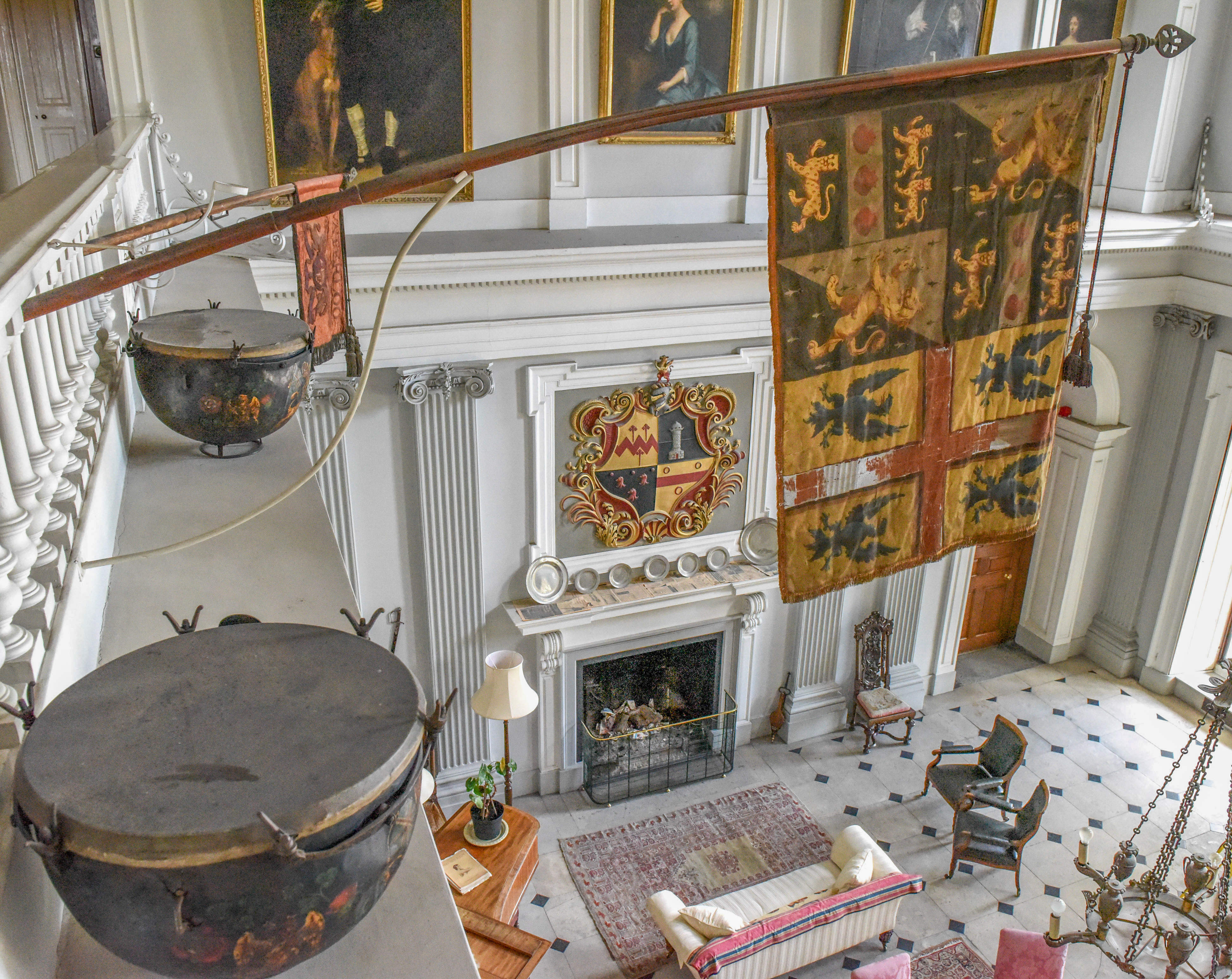A mysterious pair of painted kettle drums
Two drums with handmade butterfly lugs resided for many years on the balcony of the Great Hall at Ombersley Court. About 16 inches high and 22 inches in diameter (one a little smaller than the other), the words written above the coat of arms on each are “2nd Royal North. B. Dragoons”.
The drums were, by tradition, carried at Waterloo. The 2nd Baron Sandys of Ombersley of the 2nd creation, then Lord Arthur Hill, acted as one of Wellington’s ADCs in the battle: he was an officer in the 21st Light Dragoons, which with the Royal North British Dragoons was known as the Scots Greys. From 1832 to 1837 he was the regiment’s Commanding Officer, and, from 1858 to his death two years later, Hon. Colonel.
Recently, expert opinion has been sought and received on the drums. Jeremy Montagu, Hon. Fellow of Wadham College, Oxford and President of the Galpin Society, dates them “somewhere between 1790 and 1810, but the origin is still a mystery. I have a suspicion that… [they] might have been spoils of war, possibly German, having been captured by the French and then by the English, or French also captured.
“Somehow they don’t look English despite them then being triumphantly painted with our Royal arms. While the Greys… were certainly in the battle, would they have had their drum horse and mounted band there at Waterloo?...
“The one thing against Germany is the way the skin is attached; German style, the skin is usually the other way up, but the heads might have been replaced in the UK, so that’s not much help!... The two diagnostics that I have relied on are (a) the depth of shell and verticality of the sides, which suggest the end of the eighteenth century, and (b) the wing-nut tuning handles — T-handles came in around 1790, and before that all drums… had plain square blocks for which a tuning key was necessary… The earlier drums very seldom had such vertical sides as yours, above the curvature of the bowls… The shape of the shells cannot be altered, so my inclination is to stick to my original dating, unless any other details appear, for example evidence of internal funnels round the soundhole...
“Most such drums come as a pair with one slightly larger than the other so as to have a pitch difference between them.”
Edwin Rutherford from The Royal Scots Dragoon Museum in Edinburgh, Winfield Fellow of the US Embassy, has also commented helpfully, having consulted Military expert Stephen Wood, first on the arms that are painted on the drums. “The Royal Arms of England (NB not Scotland, or at least not the Scottish version of the British Royal Arms) appear to be those in use after 1837 (and still used). So even if the drums are earlier, the Arms are not.”
He goes on: “What you can say for certain is that the regimental title, lacking any reference to 'Scots Greys', dates from before 1866 so I think that you can say that the decoration on the drums dates [from the period] 1837-66.
“I am not sure when regiments of dragoons adopted, or were allowed, kettledrums: they were originally and traditionally (I think) only used by, or allowed to, regiments of Horse (and subsequently Dragoon Guards), which is why the Household Cavalry use them today on state occasions.
“They were certainly carried to and used on the battlefield in the early 18th century, at least on the continent, because there is a record of one of the Scots DG's antecedent regiments capturing the kettledrums of an enemy regiment during the War of the Spanish Succession... So I don't know if the Greys' band, assuming that the regiment actually HAD a band, would have had kettledrums in 1815. If the regiment's band, assuming there was one, did have kettledrums, I don't know if we know whether or not the band, or any form of regimental musicians, went with the Greys to Flanders in 1815. If it did, then I very much doubt if any elements of the band would have gone to the battlefields of Quatre Bras and/or Waterloo; I would have thought that it would have remained in Brussels - although of course the trumpeters would have gone since the trumpet was used to convey orders in the field. [Archivist’s note: The records indicate that one Greys’ trumpeter was killed at Waterloo and another wounded.]
“I rather fear that it will not be possible to substantiate the story attached to the drums… In any case, and this may not be wholly irrelevant, military kettledrums, certainly by the mid-19th century, were always draped in drum banners when in use and mounted on the drum-horse and not painted in the way that these ones are. Whether they were similarly draped when in dismounted use by the band, I don't know but I think that I would expect it.”
Finally, a surmise by CJP: “Maybe the drums (re)painted with the contemporary coat of arms, were given to the 2nd Lord Sandys upon his retirement as Commanding Officer, and/or maybe the drums were then replaced - indeed maybe he paid for new drums as a parting gift, and kept the old ones.”
Does anyone have further thoughts?
